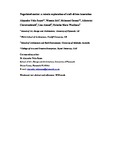Negotiated matter: a robotic exploration of craft-driven innovation
| dc.contributor.author | Veliz Reyes, A | |
| dc.contributor.author | Jabi, W | |
| dc.contributor.author | Chatzivasileiadi, A | |
| dc.contributor.author | Gomaa, M | |
| dc.contributor.author | Ahmad, L | |
| dc.contributor.author | Wardhana, NM | |
| dc.date.accessioned | 2019-07-11T09:46:02Z | |
| dc.date.issued | 2019-08-08 | |
| dc.identifier.issn | 0003-8628 | |
| dc.identifier.issn | 1758-9622 | |
| dc.identifier.uri | http://hdl.handle.net/10026.1/14628 | |
| dc.description.abstract |
This paper introduces a novel approach to craft-driven robotic innovation in architectural research. Here craft is not portrayed as a source of ornamental or historical inspiration, but instead as an open-ended process described by a framework involving material properties, diverging modes of knowledge production and representation, emergent tectonic configurations and embodied interaction with technology. To do so, this paper firstly contrasts a definition of craft (Pye 1968) with practices of robotic architectural production. Additionally, the notion of emergent tectonics resulting from negotiated material and technological processes is addressed by critically situating the theories of architectural tectonics by Kenneth Frampton (2001) and digital tectonics by Leach, Turnbull and Williams (2004) in the context of robotic fabrication in architecture. Finally, the ongoing project “Computing Craft” is presented as a case study illustrating a proposed framework for robotic craft-driven innovation. | |
| dc.format.extent | 398-408 | |
| dc.language | en | |
| dc.language.iso | en | |
| dc.publisher | Taylor & Francis | |
| dc.subject | robotic fabrication | |
| dc.subject | craft | |
| dc.subject | architectural innovation | |
| dc.subject | cob | |
| dc.subject | robotic 3D printing | |
| dc.subject | tectonics | |
| dc.subject | material eco-system | |
| dc.title | Negotiated matter: a robotic exploration of craft-driven innovation | |
| dc.type | journal-article | |
| dc.type | Article | |
| dc.type | Early Access | |
| plymouth.issue | 5 | |
| plymouth.volume | 62 | |
| plymouth.publication-status | Published | |
| plymouth.journal | Architectural Science Review | |
| dc.identifier.doi | 10.1080/00038628.2019.1651688 | |
| plymouth.organisational-group | /Plymouth | |
| plymouth.organisational-group | /Plymouth/Faculty of Arts, Humanities and Business | |
| plymouth.organisational-group | /Plymouth/Faculty of Arts, Humanities and Business/School of Art, Design and Architecture | |
| plymouth.organisational-group | /Plymouth/REF 2021 Researchers by UoA | |
| plymouth.organisational-group | /Plymouth/REF 2021 Researchers by UoA/UoA13 Architecture, Built Environment and Planning | |
| plymouth.organisational-group | /Plymouth/Users by role | |
| plymouth.organisational-group | /Plymouth/Users by role/Academics | |
| dcterms.dateAccepted | 2019-07-31 | |
| dc.rights.embargodate | 2020-8-7 | |
| dc.identifier.eissn | 1758-9622 | |
| dc.rights.embargoperiod | Not known | |
| rioxxterms.version | Accepted Manuscript | |
| rioxxterms.versionofrecord | 10.1080/00038628.2019.1651688 | |
| rioxxterms.licenseref.uri | http://www.rioxx.net/licenses/all-rights-reserved | |
| rioxxterms.licenseref.startdate | 2019-08-08 | |
| rioxxterms.type | Journal Article/Review | |
| plymouth.funder | Augmented Vernacular::Chartered Institute of Building CIOB | |
| plymouth.funder | Augmented Vernacular::Chartered Institute of Building CIOB |


